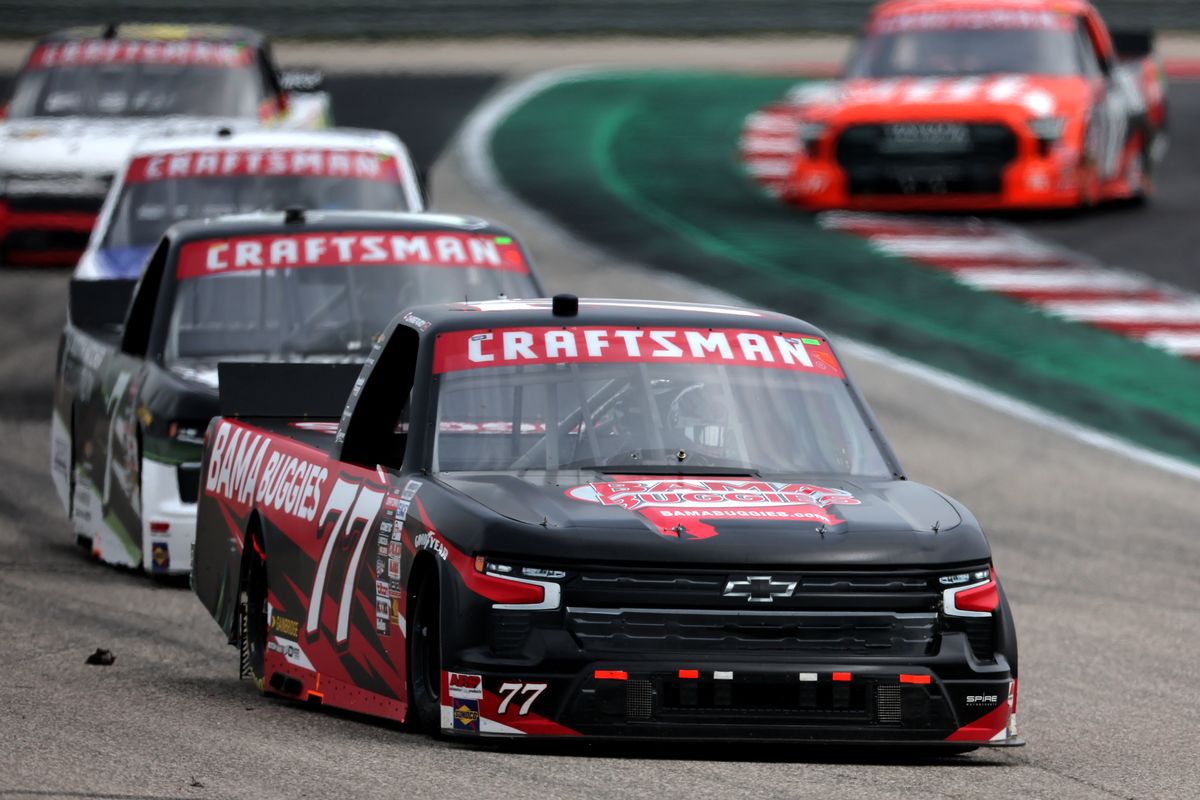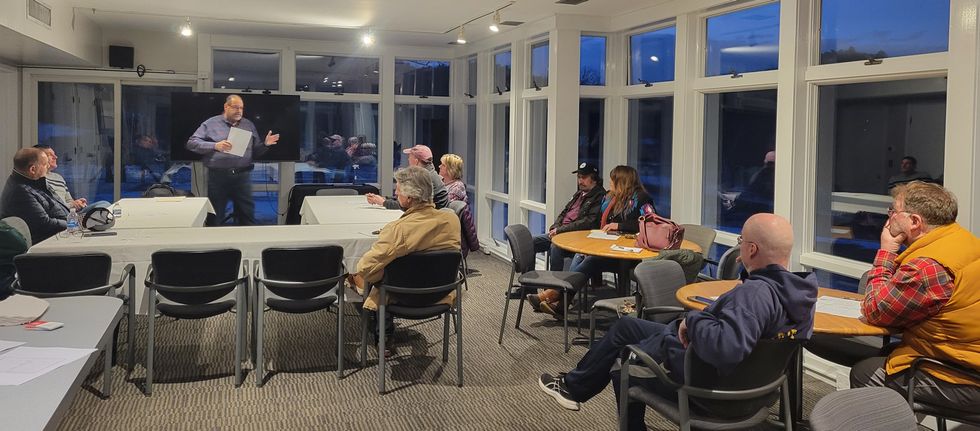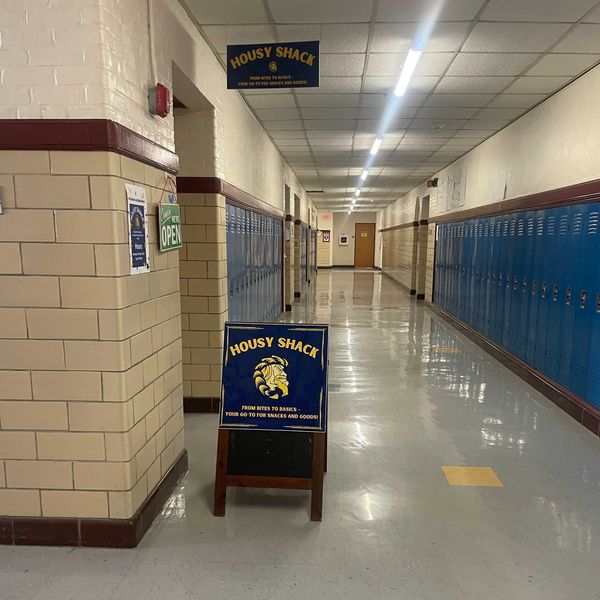Lime Rock neighbors mull offer to park cars on property for NASCAR trucks event

The NASCAR CRAFTSMAN Truck Series will make its debut at Lime Rock Park this summer.
Provided

The NASCAR CRAFTSMAN Truck Series will make its debut at Lime Rock Park this summer.
SALISBURY — Robert Jacopino, vice president of operations at Lime Rock Park, was visiting the Big E in West Springfield, Massachusetts, last fall when a “lightbulb moment” struck.
“I saw cars parked on people’s lawns throughout the neighborhoods and thought, we can have that at Lime Rock Park,” he recalled during a meeting with about a dozen neighboring property owners at the Lakeville venue’s infield chalet on Thursday, Feb. 27.
The hour long forum’s purpose was to gauge neighbors’ interests in hosting, and profiting from, patron parking on private property when the NASCAR CRAFTSMAN Truck Series rolls into town the weekend of June 27, drawing what park officials have described as “the biggest event in Lime Rock Park’s history,” with expected attendance between 12,000 and 15,000 guests.
The event, said Jacopino, will be nationally televised on the FOX network.
“We are looking to share the prosperity with our neighbors,” said Jacopino, who in late January sent out a notice to Lime Rock Park neighbors inviting them to profit by parking cars on their property and inviting them to the Feb. 27 informational meeting.
Not only is the plan mutually beneficial to the park and to residents, he said, but “this will be a great economic opportunity for the immediate area, the Northwest Corner and beyond,” including restaurants, hotels and shopkeepers.
Some signed up, others undecided
Jacopino was joined by Tom Burke, director of track operations, as they answered questions, addressed concerns and handed out a generic parking plan with suggestions on how to delineate spaces, travel lanes, entrances and exits.
As of last week’s meeting, about a half dozen neighbors indicated interest in hosting off-site parking, and a handful of others said they had not yet decided but were weighing the option and had additional questions.
Jacopino estimated that 120 cars can fit on an average acre of land, and that the parking fee will range from $20 per car within a half mile of the track to $10 per car outside of a half mile.
“It’s going to be totally your revenue. We don’t want any part of it,” said Jacopino.
Lime Rock Park plans to supply each off-site location with a 2-foot by 2-foot official NASCAR parking sign and provide shuttle service for sites not within walking distance to the event, said Jacopino.“And we checked with the town, nobody needs a special permit to park cars in their yards,” he noted in response to a question from the group.
The park’s use of off-site parking is nothing new, as the nearby Trinity Church and other large-acreage fields have offered supplemental parking during large events, said park officials.
In addition to several private property owners, representatives from local businesses including the park’s neighbor, Heather Bloom Farm on White Hollow Road, and Housatonic Valley Regional High School, offered to park cars at their sites.
In addition, said Jacopino, local Boy Scouts have offered to assist with parking as a public service.

HVRHS to offer paved parking option
Among attendees at the meeting were Melissa and Randy Dean, who said they were representing the owner of nearby While Hollow Farm and Vineyard and seeking details on the parking plan.
Jeffrey Tripp, class advisor at HVRHS, and Jeff Lloyd, facility manager, noted that the school’s parking lot would be an ideal alternative for patrons who arrive in “really nice cars” and prefer to park on a paved surface instead of fields.
They further noted that students have volunteered to assist with the parking flow.
Lloyd asked if they should plan on opening the parking area for both Friday and Saturday of the weekend event, or just Saturday.
Burke explained that Friday is traditionally the slower day for weekend events and that Saturday will lure the biggest crowds.
“Saturday is definitely the full monty,” Jacopino said.
In response to questions about parking and safety issues, Burke said State Police will provide full security, and that Lifestar “will be on the ground” both at the park and at the high school’s athletic fields in the event of a mass casualty incident.
Park officials noted that “No Parking” signs will be posted along Route 112, and along roads where off-site paid parking is being offered, and that all of the private parking areas are set back from the main roads.
“Tom has made leaps and bounds over the past two years getting the State Police involved so that there will be fewer parking jams,” said Jacopino.
Concerns about dogs, rain and litter
Dugway Road residents Linda and Thomas Walko were are “on the fence” as to whether they plan to offer their 11 acre property with an expansive, open meadow as an off-site parking location.
Linda Walko asked how to handle a situation where a patron arrives with a dog in their car, to which Lime Rock Park officials suggested they be turned away, as dogs are not allowed in the park or to remain in parked cars.
Thomas Walko, who races at Lime Rock, expressed concern that inclement weather could become an issue. “I can park a couple hundred of cars there, but if it rains, it will rip my place up.”
He also raised concerns about his fields being littered with beer cans and other trash, to which Jacopino suggested placing several visibly marked, large trash cans throughout the parking area.
The Lime Rock vice president said he has received a few calls from residents concerned about noise and traffic, but most of the feedback to the parking plan have been positive. He explained that all of the sites on private property will be “away from other people’s homes,” and on large parcels of land tucked back from main roads.
One meeting attendee asked: “Do the patrons coming aware that this is a small, New England town where there is not a lot of infrastructure?”
The Cooper family on Lime Rock Road is counting the days to the big NASCAR event, when parking will become a family affair.
Erica and Ryan Cooper said they plan to park about 200 cars on their two-and-a-half acre property. “Our three boys are pretty excited” about helping out, said Ryan.
‘Biggest event in Lime Rock Park’s history’
Lime Rock has a long history of hosting NASCAR events, having held 20 races over a 19-year span from 1993 to 2011.
After a 14-year hiatus, NASCAR will once again race at Lime Rock Park as the NASCAR CRAFTSMAN Truck Series makes its debut at the Lakeville venue the last weekend in June.
In preparation for the event, the historic park is undergoing several updates during the off-season, including an extension to pit lane and additional safety features.
“To say that we are excited about this announcement is a major understatement, as this will surely be the biggest event in Lime Rock Park’s history,” said Dicky Riegel, the racetrack’s CEO.
“The combination of the NASCAR fan base in New England with the spectacular beauty of Lime Rock will create motorsports magic in Connecticut.”
The Community Closet at HVRHS is open for students to take clothes for any reason during the school day.
What started with one unexpected donation of clothes has grown into a quietly impactful resource for all students at HVRHS: the Community Closet. Now located in a spacious area above the cafeteria, the closet offers free clothing to any student for any reason.
The idea began a few years ago when a community member reached out to the former superintendent wondering if anyone at the school could benefit from used clothing that would otherwise go to waste. The superintendent then got in contact with Rachel Novak, the school social worker. “Once I had all those bags of clothes in my room, I was like, ‘I should put this in a space,’” Novak said. Her simple idea eventually became a full-sized closet accessible to all students.
From the beginning, Novak envisioned the closet as an inclusive space. “It’s open to anybody, it’s not just based on economic needs,” she said. Sustainability also plays a role. “Thinking about the environment, some students like to thrift and just get clothes that way,” Novak said.
After the initial donation, contributions continued to grow. “I reached out to our staff members and faculty,” Novak said. The most consistent donations come from the faculty at HVRHS and a few community members who learned about the closet. Finding teenage-appropriate clothes has been a challenge. “I get a lot of donations that are nice, but I don’t think teenagers would want to wear them,” Novak said.
Another ongoing obstacle has been awareness. Many students don’t know the closet exists at all. “That’s been the hard part,” Novak said. “Getting it out to the wider community of the school.” Novak is looking for students and staff to spread the word. “It helps because our school nurse knows and other faculty members,” she said. “When they know a student needs something, they just bring them up.”
Looking ahead, she hopes to promote the space more actively. “When we come back from this break, I do plan to … get fliers and all that up and going,” Novak said. There may even be an upcoming expansion — she has discussed the possibility of turning part of the area into a food pantry. “That would be more of a need-based system for students,” she said. “But right now, promoting it is where I’m at.”
The Community Closet is well-stocked currently. “Just because of the amount of clothes I have, I’m not accepting any more donations until I clear some stuff out,” Novak said. She is still willing to make room for more fashionable, teen-friendly items donated by students. “That way I’ll have more teenager approved clothes.”
Above all, she wants students to know that no one is limited to using the space. “Sometimes there’s a stigma around it … like, ‘I don’t need help. I don’t want to take away from anybody else that may need it,’” Novak said. Due to the amount of clothes, students should feel welcome to use the closet for any reason. Some students even grab items last minute for sports and activities. “It’s important for kids to know it’s for everyone.”
Whether a student wants to thrift clothes sustainably, forgot to pack clothes for an after-school practice, or is in need of a new outfit, the Community Closet is a resource for all.
Sophomore Eliana Lang enjoys her Housy Shack cookie.
Now in its second year, the Housy Shack is a hit among students. The special education department-run store that sells warm cookies, drinks and other snacks to students and teachers draws people to a room in the back hallway every time it’s open.
The smell of warm cookies welcomes visitors to the store with snacks, drinks and even Housy merchandise for sale. The cookies are definitely the favorite, sometimes lines go out the door to get one before they sell out.
The cookies are so popular that the store had to increase prices from 50 cents to a dollar and implement a four cookie per person maximum. The Shack sells about 40-100 cookies per day and has about 20-60 HVRHS customers visiting per day.
Julie Browning and Heather Strid, two of the HVRHS faculty members that help run the Shack, said their goal was to create real-world job experiences as well as real-world shopping experiences for students at HVRHS. “Learning the skills to work in the world can be taught in a classroom, but the lessons are more meaningful and valuable when they are applied in real work situations, which is what we create through the school store,” Browning said.
The original purpose for the store seems to be working, as several students are learning important skills. Students said the store taught them skills like counting money, checking inventory and cleanliness along with social skills and customer service that could help in the professional world after high school.

As the store quickly became a hit, organizers were faced with the challenge of finding funding. “When we started planning to start the school store two years ago we needed money to buy equipment, supplies and food to start it up but were not sure how to get it,” Browning said. “Mrs. Strid came up with the idea of applying for a grant from the 21st Century Fund to help us get started and they were so generous.” That grant has been crucial to the success and growth of the school store.
Not only does the Housy Shack benefit the special education department, students said it fosters a sense of community throughout the school. “School store cookies are my favorite thing ever. They brighten up my day,” said Eliana Lang, a sophomore at HVRHS. Dayana, one of the student staffers at the Housy Shack, said her favorite part of working in the school store is when students come in to make purchases. She enjoys talking to them and ringing up their orders on the cash register. The Housy Shack brings people together and offers the opportunity for students to connect with each other.
As the school year continues, the members of the school store look forward to expanding their inventory by creating and selling a variety of Housy merchandise — t-shirts, sweatshirts, water bottles, and more. “I have had several students put in requests for certain hats, key chains, etc. … so there will be more of that to come,” Browning said. Last school year, profits were all invested back into the school store. “This year we are hoping to make more of a profit and will look to use the money that we make for field trips, outings as well as opportunities to donate and give back to the community,” Browning said. They also would like to use the school store to fundraise for other causes. “Right now we are collecting donations for The Little Guild Animal Shelter, so if anyone has pet supplies they would like to donate please drop them off in exchange for a cookie,” Browning said.